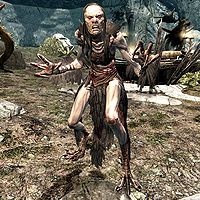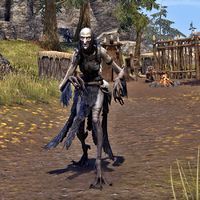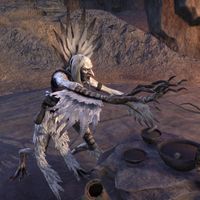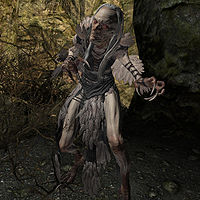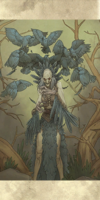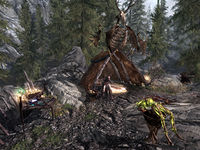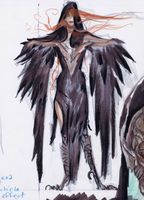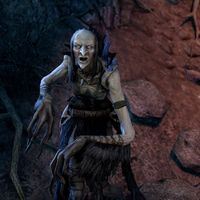Lore:Hagraven
Hagravens are creatures of corruption and decay that appear as a horrific cross between an old woman and a bird.[1]:110 They were once witches, but have undergone a ritual, trading in their humanity for access to powerful magic, and the transformations they undergo infuse their entire beings with some element of that power.[2] Hagravens consume people alive, and especially love eating fresh eyeballs.[3]
Few creatures match the cunning, depravity, and repulsiveness of the hagravens. They will take through savagery what they cannot win through guile.[4] They are usually extremely hostile to outsiders, but they retain the ability to communicate. They are equally dangerous up close or when casting spells from afar.[5] They are known for their foul stench.[6] They possess an ability to turn into a murder of crows and attack their foes from a hundred directions at once.[7]
The transformation to Hagraven is reversible, though it is unknown if it can be undone without divine intervention. On one occasion Kyne intervened and cleansed and forgave Keeper Ormi who turned into a hagraven, after her son Sahun revealed himself to still be alive and prayed for her.[8]
Culture[edit]
They can often be found in the company of Reachmen clans, who often revere hagravens as their Matriarchs and leaders, or dwelling in secret groves and lairs in the wilderness with other witches and hags.[9][10] Some clans actively revile and fear them, however.[11] The Glenmoril Witches of Skyrim were known to be hagravens.[12]
The Daedric Prince Nocturnal is considered kin to the hags and hagravens.[13] The Crow Mother is a hagraven Daedra Lord who claims to be the "Nether-Niece" of Nocturnal.[14] This hag spawned the Crow Daedra, who make up the Blackfeather Court.[15]
Stone carvings with the imagery of hagravens with a distended bellies could be found in 2E 582. It was unclear whether it represented a fertility idol or a gruesome depiction of a hagraven devouring small children.[16]
Uses[edit]
Hagraven claws can be used in alchemical concoctions.[2] Drinking vessels made of hollowed hagraven claw were believed to increase the effects of whatever alcohol it contains.[17] Quills made from hagraven feathers are typically long and sharp. They are occasionally manicured and inset with silver.[18] One of such quills was known as the Black Quill. It was commissioned by Razotha Tale-Teller, a legendary Orc lorekeeper. According to legends her quill was enchanted by an Altmer wizard to ensure that any story written using this quill would never be forgotten.[19]
History[edit]
During the Wild Hunt spawned to kill High King Borgas in 1E 369,[20] the Reachfolk captured a hagraven in Skyrim among the monstrosities that were spawned from the event.[13]
During his exile, Faolan the Red Eagle came across a mysterious and powerful hagraven, also known as simply the Hag in early works,[21] who offered him the power to free his people in exchange for his heart. Red Eagle had to clear his mind before he could embrace his destiny and filled his heart with the thing he loved the most - his people.[22] He accepted the offer and became the first Briarheart,[23] becoming a spirit of vengeance, pitiless, and beyond remorse and bringing an onslaught of violence and death to the occupying Alessians led by Empress Hestra.[24]
The conflict between the Hags of Glenumbra's Hag Fen and the Beldama Wyrd is as ancient as the Hag Fen itself. The arrival of the hagraven Mother Murk from the Reach upset the balance within the swamp, twisting the world around her. Her alliance with the Bloodthorn Cult led to an increase of abductions of women around the area to convert into hags or thralls.[25] This brought the attention of an adventurer, who with the guidance of the wandering Reach-witch Sibellec the Old, turned Mother Murk's magic against her, allowing her to be slain, and brought the Hag Fen under the control of the Beldama coven.[26]
Gallery[edit]
See Also[edit]
- For game-specific information, see the Skyrim, Elder Scrolls Online, and Call to Arms articles.
References[edit]
- ^ The Elder Scrolls V: Skyrim: Prima Official Game Guide — David Hodgson
- ^ a b Herbalist's Guide to Skyrim — Agneta Falia
- ^ A Diet of Eyes
- ^ Hagraven-related Loading screen text from Skyrim
- ^ Hagraven abilities in The Elder Scrolls Online and Skyrim
- ^ Herbane's Bestiary: Hagravens — Herbane
- ^ Crow Bringer
- ^ Events of For Kyne's Honor in ESO
- ^ A Life Barbaric and Brutal — Arthenice Belloq
- ^ Breaking the Coven quest in ESO
- ^ Medone's dialogue in ESO
- ^ Appearance of the Glenmoril Witches during Blood's Honor in Skyrim
- ^ a b Kyne's Challenge, High Rock — The Imperial Library
- ^ Crow Mother's dialogue in ESO
- ^ The Blackfeather Court — Ulysa Rervam, Proctor of Daedric Studies
- ^ Hagmother Statue item description in ESO
- ^ Hagraven Drinking Claw item description in ESO
- ^ Hagraven Silver-Quill Pen item description in ESO
- ^ The Black Quill
- ^ Pocket Guide to the Empire, 3rd Edition: The Wilds Remain: Valenwood — Imperial Geographical Society, 3E 432
- ^ The Translated Works of Tosmorn, IV — Xandier Edette
Edited by Vanesse Aurilie - ^ Red Eagle's Song quest in ESO
- ^ Red Eagle Cave Painting antiquity codex entry in ESO
- ^ The Legend of Red Eagle — Tredayn Dren
- ^ Wicked Trade quest in ESO
- ^ Wyrd and Coven quest in ESO
| ||||||||||||||||||||||||||||||||||||
